It’s a bit strange that I had to delay it as Monty is completely off grid and I wanted to get away from people anyway. The first trip was so enjoyable that the lure of freedom was pulling very hard, but rules are rules and, on this occasion at least, are not to be broken. It’s all part of getting out of lockdown – if only our politicians respected them too!
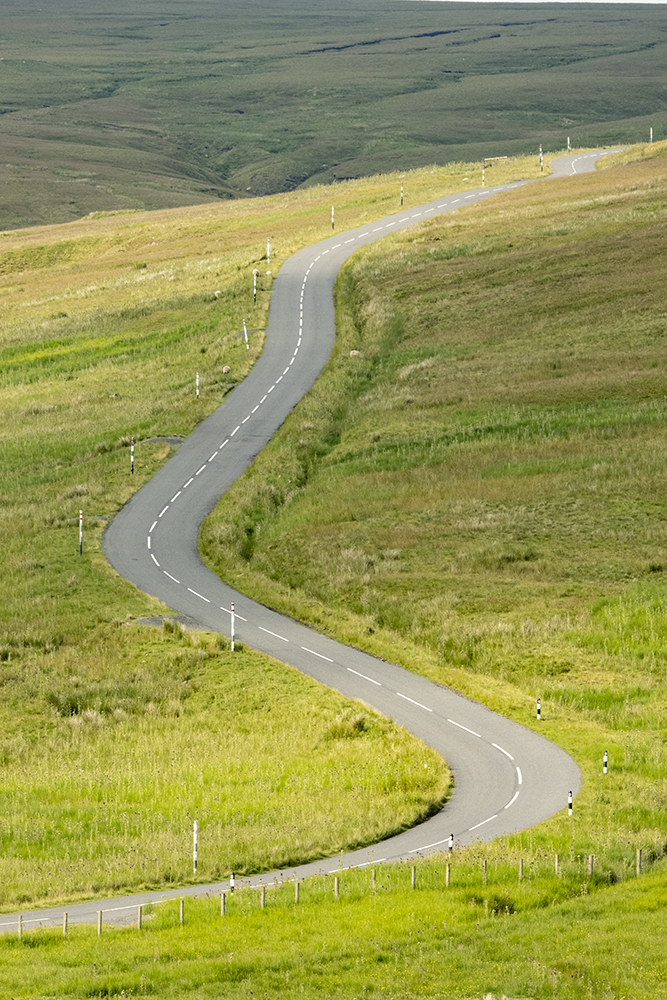
It’s a time for getting away from population centres and deep into nature. In April next year I’m leading a photo tour, group of photographers, to Namibia and one of our destinations is the Quiver Tree Forest for dark skies photography. So, with this in mind, I decided to head for Kielder Water in Northumberland National Park – just south of the Scottish border – and a well-known Dark Skies region. Now all I needed was the notorious English summer weather to part the clouds and reveal the heavens.
It’s a long journey from Suffolk so on route I stopped first at Rutland Water and then in the Yorkshire Dales. Rutland Water is a man-made reservoir – an outdoor pursuits destination and a wildlife sanctuary, primarily birds – managed by water utilities company, Anglian Water. The perimeter of the lake has a cycle and walking trail all the way around. It is also popular with anglers and water sport enthusiasts
The reservoir was made by damming the Gwash Valley near the village of Empingham. The project started in 1971, but the clay dam wasn’t finished until 1975 and it took another three years to flood just over six square kilometres of the valley. It was originally called Empingham Reservoir but later renamed as Rutland Water.
Monty and I decided that the hill above Lyndon Nature Reserve would be a good base to explore along the shoreline and see what shots I could get in the limited time available. The nature reserve has resident ospreys and at this time of year they are rearing their young. With a chick in their nest they were constantly flying off in search of food. However, with too great a distance between me and the nest, and these flights taking them even further away, it was not to be on this occasion and I had to be content with watching them instead. With more time, and special permission, I could have got something but this was a somewhat impromptu visit.
There is lots of other birdlife on Rutland Water so as the clouds began to lift and the early evening brighten up, I set about seeing what else I could photograph. There are several hides along the lake shore and these afforded some great views. Bird photography takes a lot of patience and, as with much wildlife photography is probably 90% observation. There’s something very relaxing about sitting and watching nature though, even if you don’t actually press the shutter.
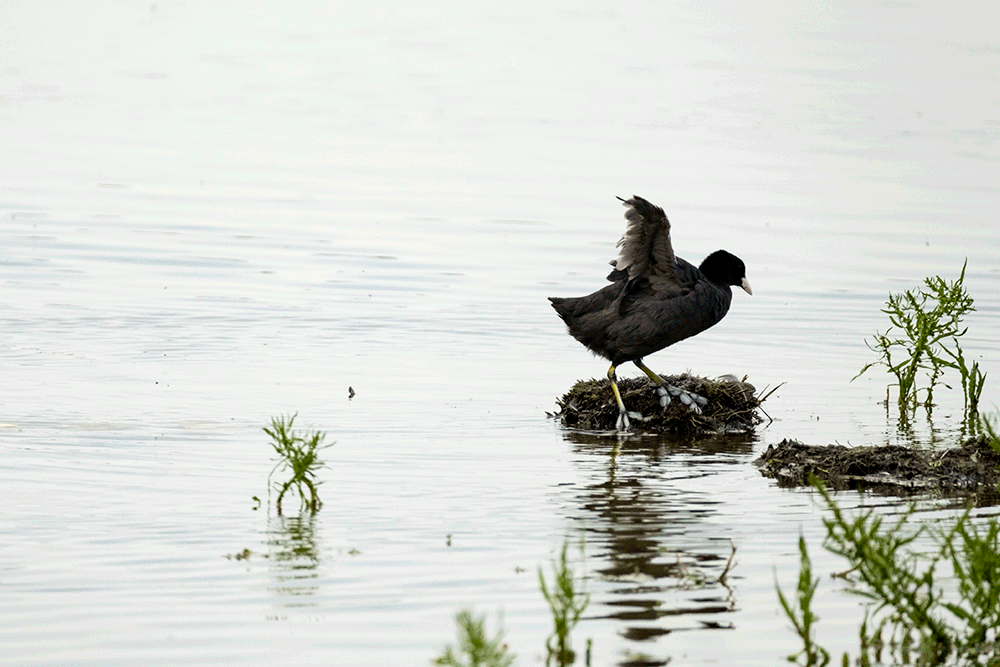
The osprey viewing hides afforded good views of some of the smaller, less spectacular birdlife. It was fascinating to observe their behaviour as egrets waded amongst the reeds just in front of me. But the star of the show was the humble, unassuming coot on its nest to one side. After a loving kiss with its mate at the nest duty changeover it proceeded to do a comical dance!
As I was about to leave for a different hide the sunlight caught a spider in its web strung across one of the lookout windows. The strands glistened in the evening sunlight, standing out more against the soft background through the use of a telephoto lens positioned close to the spider and a narrow depth of field, possible because the spider and web were in a largely linear plane. A slight move of the head changed the uniform green background to two-tone as vegetation was part-ousted by water. I can’t decide which one I like best.





From another hide the view looked out towards the slowly oranging sky. Right in front, less than two metres away, a swan and her four signets fed amongst the reeds, offering some unusually close detail shots. A local told me they were frequent visitors to this spot. A dead tree in the water, some 150-200m away, stood proud like something from Harry Potter and the Deathly Hallows. It was the ideal perch and observation point for cormorants. With the changing sky behind them, this was perfect for silhouettes of these almost pre-historic looking birds on twisted branches.


As the sun started to set I felt Monty calling so headed back up the hill. The rear doors open give a room, or bed, with a view and what a view it was that evening! The sky suddenly turned golden, bouncing light off the water but it was changing very quickly so, against all my principles, I grabbed my phone a took a shot. If I hadn’t, the light would have been lost by the time I’d set up a proper camera.
The silence was majestic that night. Only nature broke it as owls gossiped from nearby trees and the occasional ducks and geese gently made their presence felt. I’d planned on an early start but that didn’t happen. It was just too lovely there to rush off.

So where to next? I have a soft spot for the northern Pennine hills and the Yorkshire Dales National Park, though it’s been many years since I last spent any time in either. Sitting just below the Northumberland National Park and Kielder Water, they seemed like an appropriate meander and a good place to spend the night. In no hurry, we headed north and up into the Dales.
The light was bright but mostly cloudy so not brilliant for landscape photography. Swaledale carried good memories so I headed there. In 2004 I went there with TPOTY’s first young winner, Chris Charnock (then 15 years old), to meet up with Charlie Waite. Charlie was tutoring Chris for the day as part of his prize for winning the award. Below the same shot today (left) and in 2004 (right).


Swaledale is a patchwork of fields framed by stone walls and dotted with matching stone barns, joining together small villages along the River Swale. In the right light it’s a graphic landscape. Compared with my previous visit this wasn’t the right light. I took a photo so that I could see how it had changed. It felt different but in reality it was still very much unchanged
My favourite part of this dale is where the tiny road turns north up a switchback into Stonesdale then on up over the moor to the Tan Hill Inn at the top. I was concerned that Monty might be a bit too big to venture up but the road was a little wider now and, after negotiating the steep hairpins it was a doddle. The valley was busier that I remember but I guess in a time when the great outdoors beckons, it’s not surprising. The inn was a big disappointment though. It is now three times the size and with a huge outdoor area (perhaps temporary because of coronavirus restrictions), and it was too busy with people for me.




A couple of miles away, back down the Stonesdale valley, was a pull-off next to a bridge over a brook with a tin and wooden sheep shelter. This would be our stop for the night. The light was fading rapidly in the grey. I sat beside Monty and watched as the clouds descended down the hillsides. Young rabbits played in the tall grasses only a few metres away and a barn owl glided majestically and silently as it hunted along the brook some 200m across the moorland. At another time this could have been a photo, but in flat rapidly-fading light it was another of those experiences to be savoured but photographed another time.
It was so silent. The first non-nature noise I heard was a motorbike going up the road about nine o’clock the next morning. After breakfast, with the clouds still heavy, I set off north towards Northumberland. When I say north, that is the overall direction of travel but in this part of the world, heading north is more of a zigzag along long valleys with very few roads over the top. In one of these, the Teesdale valley, there are two waterfall – Low Force and High Force. Access is ticketed so you can’t just visit at any time of day but in overcast light this didn’t really matter as the lower contrast helped to show more detail. There aren’t many varied options for a view of the waterfall, and there are always other visitors sitting in your shot, but the power of the water intrigued me so out came the tripod and long lens for close ups of the crashing water – far more interesting than the picture postcard overview shot of the falls itself.


Next stop for us was Blanchland, a wonderfully historic village on the borders of Northumberland and County Durham. It was first settled by white-robed French monks (Canons of Premontre) in 1165 with the completion of an abbey. The name came from the colour of their clothes. It’s had a chequered history. Bought by Bishop of Durham, Nathaniel Lord Crewe in 1708, the village was built from the stones of the original abbey. Blanchland became part of a charitable trust established in his will and is still in trust to this day. At one point it fell into disrepair until lead mining came to the region and it was rebuilt to house the miners.


Nowadays it’s a bit chocolate-boxy but none-the-less a beautiful stone village. I had momentary sunlight there to bring it alive but by the time I’d parked Monty in a car park which said overnight parking was permitted, this was going. Returning to the van, a local busybody informed me that overnight parking wasn’t permitted, but they hadn’t got around to putting the sign up yet! I wasn’t up for a battle so simply headed a few miles out of town to the Derwent Reservoir and parked up there.
This is red squirrel country and I’d long wanted to photograph these adorable but increasingly rare little creatures. I’d seen signs around the reservoir but a chance encounter with a ranger pointed me in the right direction. Apparently photographers have been hounding the squirrels to get their shots, rather than just observing and waiting, so I’m not going to publicise the location.



Sure enough, after a little while and patient wait, they started to emerge, timidly posing for pictures. This was all about patience and waiting for the right moment, waiting for the squirrels to be comfortable in their own environment and not perceive us as a threat… the pictures follow when they are. As the morning moved on other people started to arrive and the squirrels retreated into the denser vegetation, but I was delighted to see and photograph them in their natural habitat beforehand.
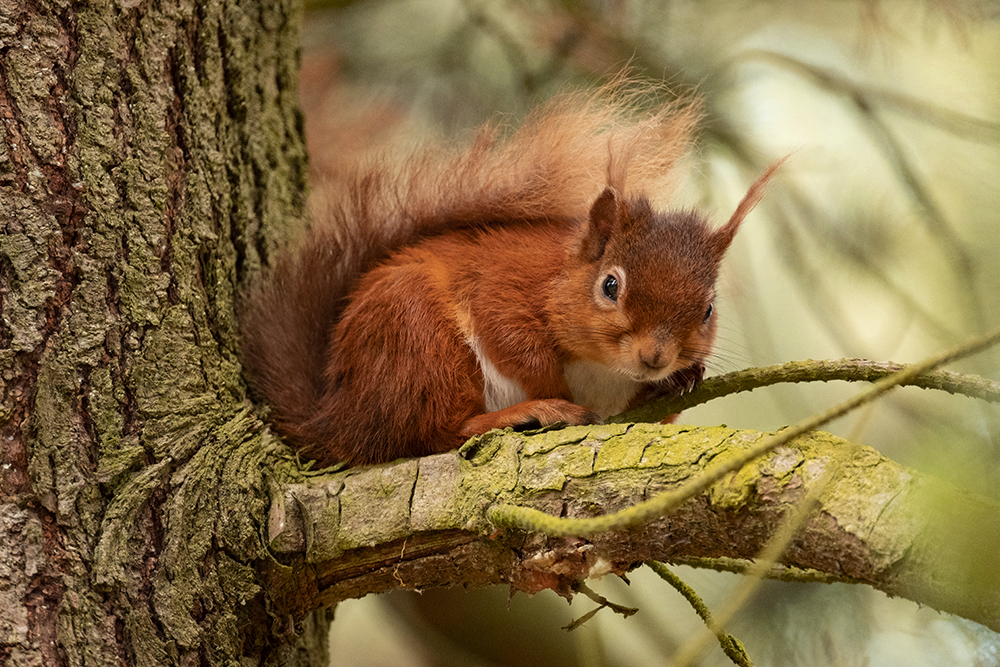
Next stop Kielder Water and a chance to stay in one place for a few nights, midges permitting. I’d timed my trip for a new moon and the least light in the sky. Now all I needed was clear skies but all I got was cloudy ones! Despite setting my alarm for the antisocial hour of 2am on two nights, the clouds didn’t part enough for dark skies photography – the only reason I’d gone there. At this time of year and this far north the light doesn’t go out of the sky much before midnight and by 3am it’s starting to get light again. However, there’s always something to photograph so I focused in on nature – flowers, ferns and other things. Patterns, colours, textures and shapes which caught my eye in the forest.


As with any subjects which have already been photographed a million times, I decided to experiment with abstraction through viewpoints, focus and framing. You can judge for yourself whether they worked or not, but I had a lot of fun trying, followed by a very good bottle of wine back at basecamp (aka Monty)!







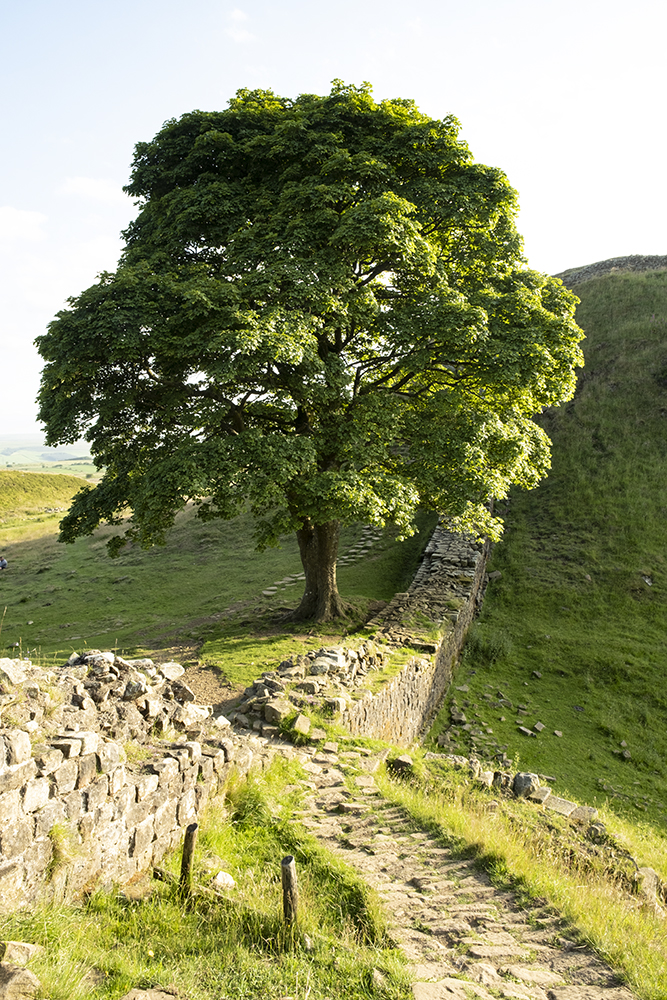
South of Kielder lies the remains of Hadrian’s Wall. It’s been excavated in many places and is surprisingly intact along some of its length. One of the most impressive sections is at Steel Rigg from where you can walk to the famous Sycamore Gap of many a photograph sits in a dip next to the wall. Again the weather wasn’t playing ball and the sun direction, when it eventually put in an appearance, was all wrong but this location is none-the-less stunning. Again, I got pictures but none as impressive as I’d hoped they would be.
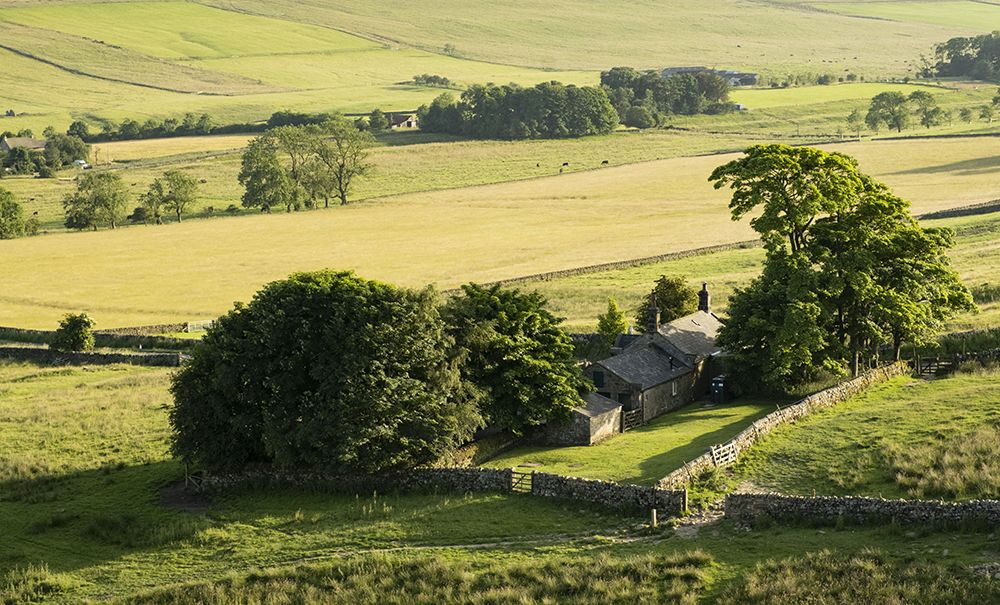
But wait, by 8pm that evening the sky was suddenly clearing dramatically and the forecast for the next few days was good. We had planned to head south again the next day, so going back to Kielder wasn’t really an option. I decided it was time for a Monty challenge and see if we could get back to that lovely spot back south in Stonesdale, maybe even before dark. The drive took just over two hours on some of the twistiest road I’ve ever been on! I felt like I’d wrestled with a bear for the whole of that time, but Monty did it. I parked him up for the night in that same layby as I’d stayed in a few days beforehand.
As I ate a late dinner, the crescent moon was setting over the hill and the gentle glow of the last colours of the day welcomed the first stars. Apart from this being a great place, the reason I went back was to see the difference in sunlight and to get a drone shot or two. The contrast between the two visits was striking as you can see, but that’s why we love photography.
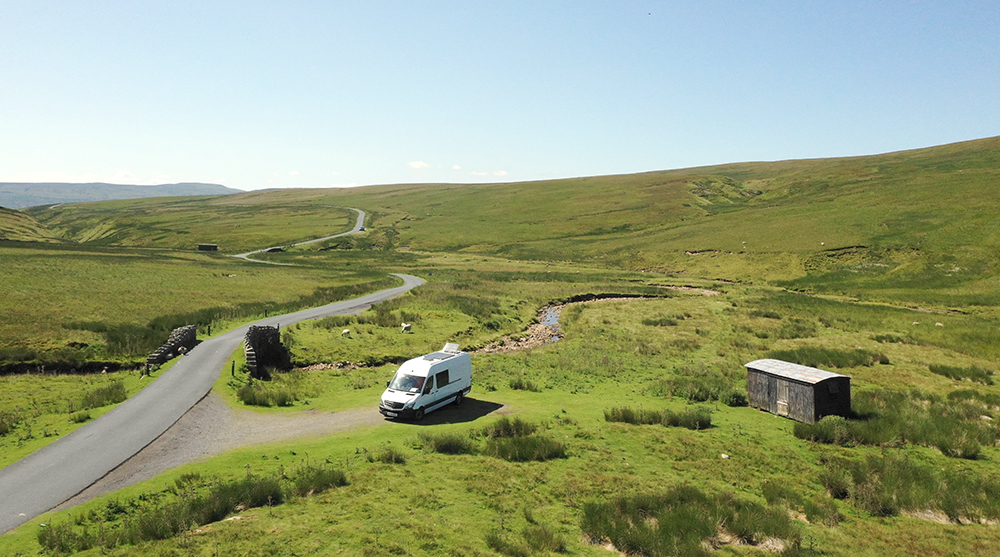
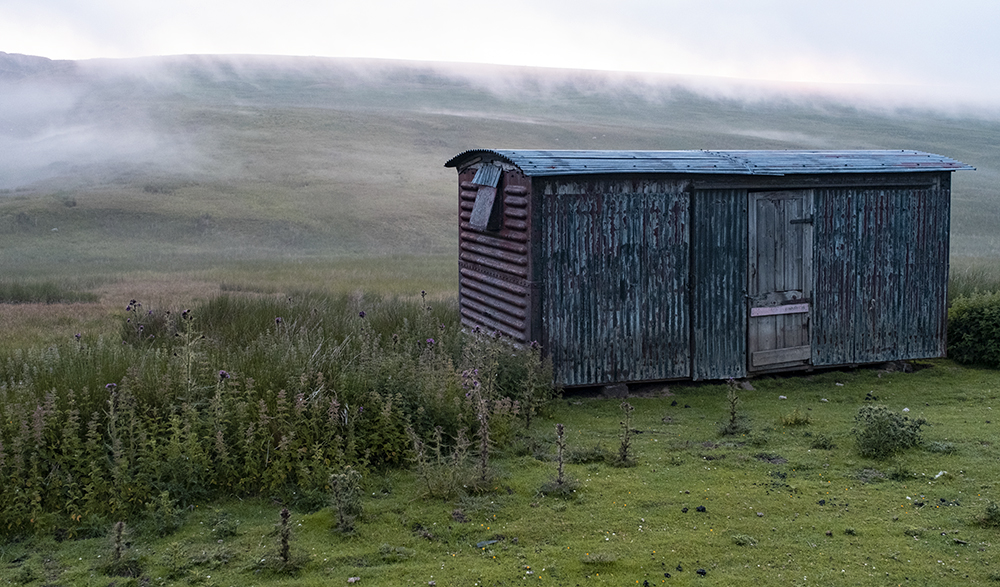
I often find that less than perfect weather brings out creativity and forces us photographers to think about our craft in different ways, to look differently and experiment, rather than lapsing into a more predictable approach. For this trip the weather was exactly that – less than perfect – but it was hugely enjoyable photographically even if the pictures won’t set the world alight.
The journey back was long but surprisingly good until I hit roadworks around Cambridge, within striking distance of home. It was half past midnight by the time I got back. A clear starlit night spread above and guess what? Starring back at me from my garden was the Milky Way!
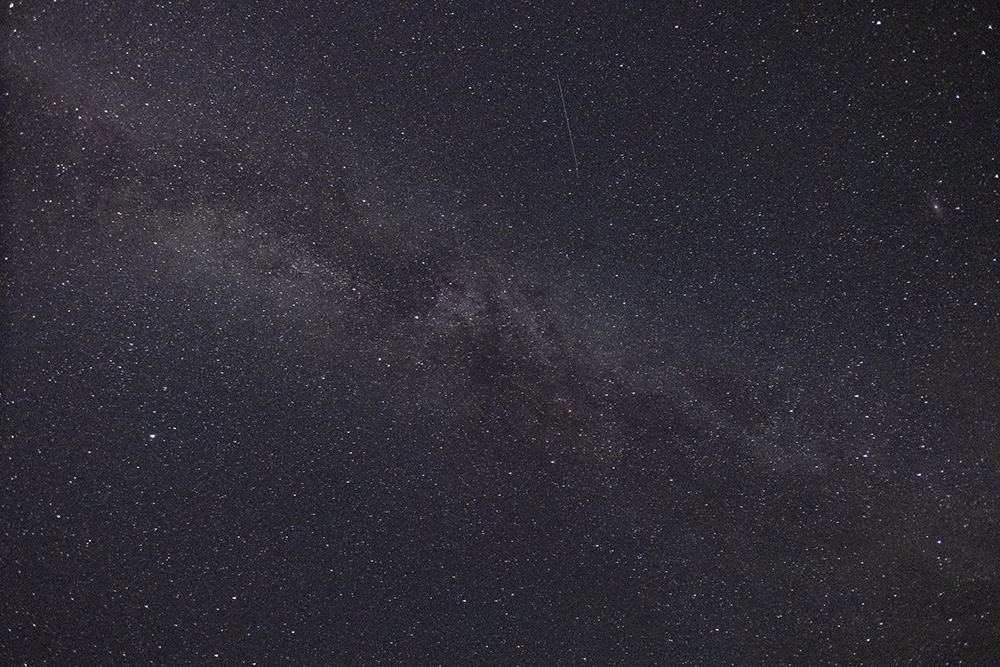
If you’d like to photograph the night sky then join me next April when I’m leading a group of photographer to Namibia. We’ll be photographing the night skies in the Quiver Tree Forest and we’ll see more stars than you ever thought existed. Monty’s staying home!

